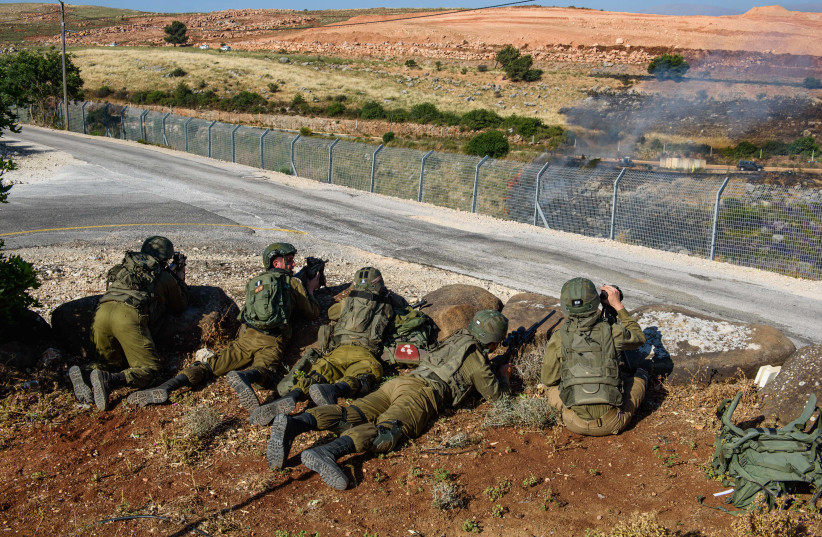Is Israel progressing with Hezbollah or is terror group’s retreat temporary?
According to senior sources, the IDF’s slight escalation in the North, in the form of slightly deeper attacks against Hezbollah in Lebanon, has led the terrorist group to voluntarily pull back some of its Radwan Special Forces – either halfway or fully – from the border with Israel.
Is the IDF starting to achieve a strategic change in Hezbollah’s force posture, which could serve as a basis for a new post-war reset? Such a change would allow residents to return to their homes.
It could very well be, though, that less has been achieved than meets the eye. There are two possible scenarios in which this is the case; either way, the big question of what will happen with Hezbollah and the North could still be wide open.
Firstly, the leak could be a political move to set the stage to avoid or fully delay taking major action against Hezbollah, even once the “main war” with Hamas is expected to end in mid- to late January.
It is well-known that Defense Minister Yoav Gallant and other top IDF officials already wanted to strike Hezbollah hard on October 8. It is equally well-known that Prime Minister Benjamin Netanyahu, war ministers Benny Gantz and Gadi Eisenkot, and a few other military officials opposed that strike, preferring to push off dealing with Hezbollah until after the hopeful defeat of Hamas.

Perhaps portions of the group who are wanting to avoid, or at least further delay, a larger scale conflagration with Hezbollah are leaking mild partial or temporary tactical retreats by the Lebanese-based terrorist group to justify their position.
Alternatively, some of this could be Hezbollah seeking to lure Israel into a false sense of security. Both Hamas and Hezbollah were surprised by the intensity of Israel’s response after Hamas’s cross-border rampage attack, in which its aggressors killed at least 1,200 Israelis and foreigners and took some 240 people hostage.
They expected a more risk-averse, blood-averse Israeli public, one that they had gotten used to over the last 17 years – since the Second Lebanon War in 2006.
Hezbollah, though, correctly diagnosed that Israel’s fury and focus are not forever, and that risk-averse trends are returning to its society – and will likely be more dominant once the main fighting stage with Hamas ends.
Hezbollah Chief Hassan Nasrallah may be betting that if he orders a temporary tactical withdrawal of some units from close to the border, he can slowly and gradually return them over time after the war.
But if the northern border goes quiet for a few months after the main fighting ends in Gaza, will Israel be ready to risk another major conflict, simply because a few dozen Hezbollah troops move a kilometer this way or that?
Will Israel be ready to risk another major conflict?
Incidentally, this suspicion appears to be the reason that the IDF itself is not making a public comment on the issue.
The Jerusalem Post has confirmed though that the IDF has noticed fewer Hezbollah forces close to the border in recent weeks.
However, the military feels that discussions about whether half of Hezbollah’s forces have pulled back, and whether they are around the Litani River, is the wrong way to judge progress and the future strategic picture.
Rather, there are objective indicators, one of which is whether Hezbollah forces are still firing rockets or anti-tank missiles on Israel. If they are, that is unacceptable, and any such forces must be attacked and destroyed.
Likewise, the Litani River is viewed as somewhat of an overused slogan, because portions of it are farther from Israel while others get quite close.
A more relevant objective indicator is whether all anti-tank missiles are eight kilometers or more away from any relevant part of Israel’s border – once again given that the border is not straight.
Eight kilometers is the range of such weapons, so that is the minimum range they must be away from the border – whereas some threats might be allowed to be closer – and some, such as longer-range rockets, would need to be even farther away.
According to the IDF, the main approach is that each kind of weapon and force should be as much out of range as possible so that Israel should have maximum warning time to prepare and deflect any attack.
On top of that, the IDF knows that it will need to work hard after the main war with Gaza is over to maintain a much larger troop presence on the border with Hezbollah, but one that will still be much smaller than it currently is.
Part of this will be a long-term challenge to the country since it will require much more extended reserve duty service than in past years, something which will require creativity to not excessively harm Israel’s economy and its social fabric, in terms of reservists with families.
After all that, the IDF is cautiously optimistic about Hezbollah’s partial withdrawals, but does not feel that it can declare any kind of victory until withdrawals to more militarily relevant lines are made and attacks are stopped.
This means that both the diplomatic and bigger-war options are still on the table.





Comments are closed.